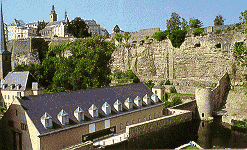|
Luxemburg |
 |
|
Luxemburg |
 |
In the Roman time, Luxemburg is situated in the intersection of two Roman ways. The cliff of Bock is already strengthened.
|
In the X-th century, a castle is built on Bock by the Count Sigefroi and the high city receives its first surrounding wall. In 1555, Luxemburg belongs to Charles the Fifth who strengthens the city. These fortifications are strengthened by Vauban, when the city becomes French in 1684. The Prussians occupied then Luxemburg up to the treaty of London, in 1867 , which proclaimed the neutrality of the country. Although neutral, Luxemburg was invaded by the German army in 1914 and in 1940. |
 |
For these 2 days spent in Luxemburg, we
did magnificent ballads interrupted with small very nice meals taken on the Military exercise place.
We took first of all the road of the ledge which follows the ancient
ramparts, with an open view on valleys. Attention to those that are dizzy, one overhangs the valley of Alzette and we are at the level of the bell tower of the church Holy Jean du
Grund.
 |
Then, we went to get lost in the Bunkers of Bock, dug in 1745, which allowed the time the communication inside the fortress. During the 2-nd world war, this labyrinth served as shelter. |
|
The old town, the ancient strengthened surrounding wall surrounded with valleys, largely reserved for the pedestrians, calls up to the stroll as well as the valley of Pétrusse, the vast park crossed by the bridge Adolphe. |
|
|
|
The Grand-Ducal palace, fancient City hall, constructed of the 16 ° in the 19 ° century. The nurse is less impressive than that of Buckingham but the palace full of charm. |
|
Just a step from there the district of the ministries which looks like a village and the Cathedral Our Lady with its fine constructed arrows very recently (20-th century). |
|
|
|
In 1952, Luxemburg becomes the seat of the C.E.C.A.
(European Community of the Coal and some Steel). Since 1957, the city accommodates the Secretariat of the European
Parliament. Since 1967, numerous European institutions settled down in Luxemburg, notably the national audit office, the European Investment
Bank... |
What we like in the Luxembourgian cooking
|
|
|